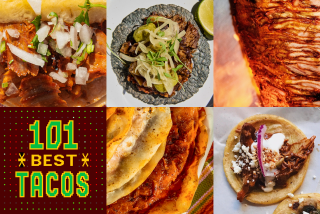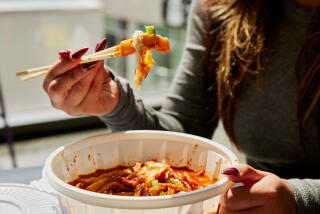New cookbooks offer recipes for Persian, Turkish and Uzbek cuisine
Because I am a very lucky person (and the host of a long-running food-focused radio interview show, âGood Foodâ on KCRW), cookbooks get dropped off at my doorstep every day; the fall publishing season always results in a deluge. But this year, the abundance has had a particular and unexpected focus. Day after day, Iâve gotten books on Persian food; books on the food of the greater Persian empire, including Central Asia and the Caucasus; a book on Turkish cuisine. One expects baking books this time of year, or coffee table books for the holidays, but this is different; this is an emphasis on a particular part of the world, one informed by wave after wave of invasions, where people of many different cultures and religions live side by side in sometimes challenging topography.
Why this? Why now? Iâm preparing for a UCLA class next spring on food of the Silk Road, so as the books began arriving, I started a stack: âTaste of Persiaâ by Naomi Duguid, âSamarkandâ by Caroline Eden and Eleanor Ford, âThe Saffron Talesâ by Yasmin Khan, âPersepolisâ by Sally Butcher and âTurkish Delightsâ by John Gregory-Smith. All these books were released within weeks of one another; the first two were published in the U.S., the last three are U.S. versions of books first published in Britain.
The Silk Road was a collection of overland trade routes created by a chain of markets trading from China to Turkey. Asia was connected to the Mediterranean by crossing Central Asia, Persia, the Caucasus and a bit of India. The network was active from approximately 114 BC to the 1450s. It created literal and metaphorical paths for trade and cultural exchanges of many kinds, including food, of course. We in the West tend to see this region as one of past Soviet occupation, conflict, intermittent war and terror attacks â and now a problematic wave of migration. We rarely experience the positive, daily human side of people attached to these lands, melting pots of culture. Food is a bridge. Why writers longed to walk across this particular one now is an interesting question.
More cookbooks: 27 of our favorites | Anthony Bourdain on dad food | Cookbook industry | Dorie Greenspan on cookies
When I asked Duguid what she thought of the current profusion of books on the Silk Road, she said she didnât think in such a context; rather, she was âmapping a culinary region that happens to lie along those trade routes â and invasion routes.â Iâd say trade is a kind of invasion. Duguid is a Canadian food writer and photographer who for years has been writing deep-dive books with a photographic National Geographic bent and recipes that work; âTaste of Persiaâ is her seventh book. Her photography and personal head notes reveal a cook-traveler who learns through relationships. She writes about being swept into the embrace of the dailyness of a Kurdish kitchen belonging to the mother of a journalist friend and watches an extraordinarily thin bread take shape. The exploration of Kurdish communities is particularly timely. Duguid captures dishes that reflect history and culture while being simply whatâs on the table.
The food of the area explored by these cookbooks is gutsy but not heavy. On one level, the simplicity of grain- or pulse-thickened soups and fire-cooked meats is elemental. But the region of Central Asia is also home to wild forests of fruits and nuts that are the ancestors to many of our domestic varieties. Walnuts, apples, plums, pistachios, cherries and almonds take the basic dishes and lift them up with jolts of sweet, sour and nutty. Throughout these cuisines, thereâs a recurrence of dried Turkish apricots â a fruit that originated in China, a perfect Silk Road story. Most of the food isnât technical, although some of it, like the more complex flatbreads, pulled noodles or stuffed vegetables, require surrender to a bit of time, practice and patience. There are simple grilled meats, rice pilafs and grain soups in abundance. Most of this food is exceptionally economical while being loaded with flavor.
All these books are great reads as well as cookbooks. They use to great effect photography of cultural treasures like textiles, tile and exquisite architectural detail with vibrant images of the foodstuffs themselves. Turquoise skies and the domes of mosques add a sense of place. Itâs all texture: the places, the foods and the imagined aromas as we read these books resulting in a welcome, deeper understanding of places that have received little of our attention.
Itâs fascinating to me that all these books were written by Canadian or British authors. I think it demonstrates that maybe American authors and publishers have been more seduced by France, Italy and the Middle East. Brits have been traveling more widely than Americans for longer; I think they have more of the get-lost-in-a-foreign culture gene than we do. âSamarkandâ is the armchair travel book of the lot. Its author is clearly at home there; Eden leads tours to Samarkand and environs. Sheâs a journalist and travel writer based in London who contributes news and travel stories on the region to the Guardian and BBCâs Radio 4. Her essay on the survival of the mountain Jews of Azerbaijan is an example of how deep her travel reaches. Edenâs co-writer, Ford, is a talented journalist known for making âglobalâ food accessible for the home cook.
âAs for âwhy now,â â Eden said, âone reason could be that, given not many of us are traveling to many countries in the Middle East once popular with tourists â Syria, Egypt and so on â safer Islamic countries are on the rise, like ones in Central Asia.â
Iran acts as the bullâs-eye for several of these books, with food from cultures of âgreater Persiaâ radiating outward. Khanâs âThe Saffron Talesâ is the most focused on Iranian food and the most personal â the only one for which the author is of the culture she explores. The London-born and -based Khan spent summers on her grandparentsâ rice farm near the Caspian Sea. This cookbook, funded through Kickstarter, explores the countryâs cuisine with an emphasis on vegetarian eating. Her food is a sensitive balance of tradition with modern tweaks while being presented in a regional format, unusual for a Persian cookbook.
Not Persian herself but married to a man from Iran, Butcher runs Persepolis, a much beloved deli-shop and adjacent cafe in London. Butcher fell in love with the man, and the cuisine and the culture quickly followed. The shop in the Peckham area of London is considered an institution, its quirky curation a hallmark. That same colorful, often untraditional, style runs through the cookbook.: Think: Marmite hummus.
Love also caused the next author to fall for a cuisine. The lone male writer in this collection of books, Gregory-Smith, is also the only one writing solely about Turkish food. He is a London-based chef, food and travel writer and the founder of the Eat Travel Live website. His introduction to Turkey began with yearly vacations there with his father but his romance with a Turkish man, followed by commitment, familial connections and more travel, deepened his knowledge. Gregory-Smithâs culinary passion is the regional home-cooked dishes that are simpler than much of the classic Turkish repertoire.
In these five books, the exploration of historic food cultures is given much texture by each authorâs connection to the region â and the stories they tell. Over the years, Iâve read a few cookbooks that cover these cuisines individually. Darra Goldsteinâs âThe Georgian Feastâ comes to mind, as does Paula Wolfertâs âThe Cooking of the Eastern Mediterranean,â published in 1994, the first that made me pay attention to the region as a whole. Books covering Armenia, Azerbaijan and Uzbekistan are occasional and tend not to have strong distribution. There are many books on Persian cooking, the most influential being Najmieh Batmanglijâs âFood of Life.â
But the five Iâve explored here differ in their breadth and context of place, with lavish photography of people, places and food that pulls you in and humanizes a part of the world that we in the U.S. tend to marginalize. They were also written by authors who traveled through the countries very recently, which lends an immediacy and a relevance to the work. âTaste of Persiaâ and âSamarkand,â in particular, with their focus on the similarity and interconnectedness of cuisines that cross borders, are especially interesting at a time when the needs of vulnerable people are so politicized.
More to Read
Eat your way across L.A.
Get our weekly Tasting Notes newsletter for reviews, news and more.
You may occasionally receive promotional content from the Los Angeles Times.







